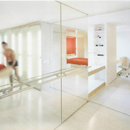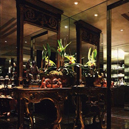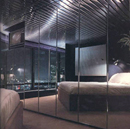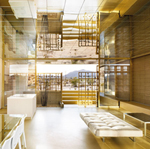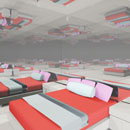
Kaleidoscope
Kaleidoscope describes an interior space in which two reflective planar surfaces are placed perpendicularly to each other, such as a mirror wall and a window wall, or a mirror ceiling and a mirror wall. The planes create a kaleidoscope of reflections. more
Kaleidoscope | Apartment
application
Beginning in the 1920s Kaleidoscope became a popular intervention to visually enlarge apartment spaces. In the 1920 to1930 decades, Kaleidoscope was a popular effect of Art Deco foyers and bathrooms. Currently Kaleidoscope is employed for living rooms of high-rise urban apartments as a way to capitalize and expand city views. At night, artificial lighting provides multi-dimensional views different from those in daylight reflections.
research
Kaleidoscope is the result of years of experimentation in mirror usage, beginning in the 17th century. During parts of this history the mirror has loomed large as a framed object, but the Kaleidoscope effect emerged from the paneling of whole walls with mirrors. If one wall resulted in a good effect, then why not add a second wall in the same space? The window walls of the Modernist and International Styles were so highly reflective that soon they were regarded as another type of mirror. This reasoning brings us to the archetypical practice of the Kaleidoscope effect in luxury apartments.
By 1670 the idea of facing walls with large areas of mirror-glass became increasingly popular to French architects and their clients. Decorators had achieved some striking effects in relatively small rooms by abutting plates of mirror-glass to form larger panels.
Perhaps the most well known of the French interiors is the Louis XIV Palace of Versailles (1678). Set in an elaborate complex of landscaped formal gardens, the Palace includes the famous Galerie des Glaces (Hall of Mirrors), the plates of which were blown in Venice. The gallery is comprised of seventeen mirror-clad arches that reflect seventeen arcaded windows overlooking the gardens. Lighted its entire length (75-meters), the gallery’s surfaces reflect an opulent décor of glistening marble, shiny gilt bronze ornaments, glass chandeliers, and a painted ceiling.
In 1678 NicodemusTessin (1654-1728), a Swedish architect, installed a mirror ceiling in the closet of the Princess of Orange at the little Dutch pleasure-palace at Honeselersdijk. By 1700 the princess of Germany also had a glazed bedchamber, as well. Throughout the 17th century glass and mirror makers continued to increase the size of individual plates.
In the 18th century architects set small panels of mirror-glass into the chimney-breast above a fireplace opening and below an inset painting or some other form of ornament. In Paris between 1685 and 1720 decorative art (vases, tables, candle-stands, door-furniture, silver ware, arabesque wall-decoration) were placed in front of mirror-glass and the chimney-breast. These panels formed a background for a display of art objects, each arranged on a separate bracket to form exciting visual patterns in reflection.
In 1786 Paris, the bed, which stood opposite the windows, was surrounded with panels of mirror-glass in such a way as to reflect exterior views and to simulate an occupant’s feeling of lying in the open air. The integration of outside and inside achieved with mirror reflections sometimes provides panoramic views which help to determine furniture arrangement.
The Arts and Crafts movement in 19th century England and the United States valued natural, matte materials and deemphasized bright and shiny surfaces for domestic and office interiors. Photographs of high-style or ordinary houses alike indicate the occasional use of framed mirrors in parlors and living rooms, but the mirrors are not large.
In 1925 the Exposition Internationale des Arts Decoratifs in Paris influenced a new decorative arts movement known as Art Deco that remained popular until about 1939. New materials, such as aluminum, stainless steel and Lucite, as well as glass, copper and gold leaf added to a lavish interior aesthetic adopted by hotels, office towers and movie theaters, such as the Chrysler Building in New York City.
The Pittsburgh Plate Glass Company, in 1923, extolled the virtues of mirror walls in shops, hotels and particularly restaurants where “very few people are willing to sit facing blank walls. A feeling of discomfort is common to most human beings when they sit thus turned away from companionship.” Pittsburgh characterized an unbroken series of mirrors for the walls as expedient and desirable, because no matter where a guest sat, other people were visible. Mirrors were the most economical form of decoration, Pittsburgh reasoned, because at night lighting added brilliancy to the scene, and the mirrors were a permanent surface and easy to clean.
In the late 1920s Coco Chanel renovated her Paris apartment in the Hotel Pillet-Will by covering the wooden wall paneling, which she disliked, with mirrors. The effect gave the rooms ambiguous spatial quality, but one with an undeniable grandeur and richness. The kaleidoscope effect was further increased with other reflective surfaces of furniture, furnishings and artificial lighting.
American interior and industrial designer Donald Deskey (1894-1989) created many lavish Art Deco apartment interiors for prominent New York City clients, such as Abby Aldrich Rockefeller in 1929 and Helena Rubinstein in 1930. In 1927 Adam Gimbel, newly appointed president of Sak’s Fifth Avenue store, commissioned Deskey to design his Park Avenue apartment. Deskey finished the Gimbel’s study with a polished copper ceiling that produced reflections with a Kaleidoscope effect, a treatment that Desky repeated in several apartments. His earliest model for the interior of an apartment, shown at the American Designers' Gallery, New York, in 1929, included cork-lined walls, copper ceiling, movable walls, pigskin-covered furniture and a linoleum floor. He was one of the first American designers to use Bakelite, Formica, Fabrikoid, brushed aluminum and chromium-plated brass, in combination with other industrial materials.
Another early 20th century Manhattan interior designer, Rose Cumming (1886-1968), was also drawn to the use of shiny materials with reflective effects. In the 1930s, for the design of her own house on West Fifty Fourth Street in New York City, Cumming installed polished floors and mirrored nearly every surface of a dressing room that opened into an entry hall. Mirrored panels in the foyer multiplied the image of a Chinese temple pagoda and marble goddesses, over which she suspended an 18th century crystal chandelier in the form of a galleon.
During the 1920 and 1930 decades, Art Deco bathrooms became the site of Kaleidoscope reflective effects with the use of mirrors and pigmented structural glass (PSG), first introduced as a re-facing material for downtown storefronts. The chains of Rexall Drug and Russell Stover Candies both used mirrored dark cobalt blue PSG as their trademark fronts. Known by the trade names of Carrara, Vitrolite or Sani Onyx, the glass came in many colors. The Pittsburgh Glass Company manufactured white, opaque Carrara as a substitute for marble, and Black Glass that had the appearance of polished jet. Interior architectural uses included wall base, wainscoting, partitions, interior walls and ceilings. Architect Cass Gilbert designed bright and spacious men’s and women’s restrooms of the Woolworth Building (1913) and used Vitrolite and white Carrara glass surfaces of which craftsmen sheathed on all of upper office floors. The Chrysler Building’s Cloud Room (1930) included an etched Vitrolite mural. Black Glass, silvered to give it a rich mirror finish, was used as panels in Art Deco bathrooms in public, as well as residential buildings, including extravagant apartment bathrooms. In 1931, for the showman Samuel L. Rothafel and the Rockefeller family, Deskey created the interiors of Radio City Music Hall introducing aluminum foil wallpaper in the men's smoking lounge.
Film star Tilly Losch’s 1932 bathroom in her London home caused a great sensation with the use of new reflective materials, including polished glass walls and a tilting ceiling mirror. Artist Paul Nash used inch-thick stippled cathedral glass, which is pure white, but treated it with alloy silvering to produce a deep metallic purple color. The doors and electric radiator were treated with silvered reeded glass alloy; all additional metalwork was chromium plated. The composition of the wall resembled a Cubist painting rendered in reflective materials of different sizes, colors, tones, and textures. The Kaleidoscope effect of mirrored planes created a dramatic aesthetic impact.
In the 1931, Oliver Hill (1887-1968) installed panels of beveled mirrors without decorative frames for the walls, ceilings, decorative panels and door architraves in a bathroom for the Gayfere House in London. In front of a mirrored wall, Hill placed decorative objects, such as vases and perfume bottles, on glass shelves. Combined with the reflective fronts of a lavatory and a chest, every surface became available for reflection. Altogether the walls, ceiling, cabinet fronts, shelves and accessories formed endless Kaleidoscope effects made more capricious with electric lighting.
At the end of the 1950s, Michael Inchbald created a space of endless vistas with opposing mirror-glass panels and boldly scaled inlaid flooring at his own house in London. In the entrance lobby two symmetrically placed obelisks reflect over and over again. If one of the outer doors if folded back against a mirrored wall, a door handle in the shape of a lion’s face seems to float into the kaleidoscopic scene.
International Style glass and steel high-rise apartments define the luxury apartment market in the 1950 and 1960s decades. Corner apartments, such as those in the Mies van der Rohe designed Lake Shore Drive Apartments (1949-1951) in Chicago, are comprised of perpendicular window walls whose reflective qualities have much the same effect as a window wall and a mirror wall. John Heinrich and George Schipporeit, who were both students of Mies van der Rohe, designed Lake Point Tower in 1968. The placement of a mirror wall perpendicular to a window wall creates a double image of the views outside the window of Lake Michigan's shore. Also in Chicago, Bertrand Goldberg’s sixty-story round apartment towers, Marina City (1959-1964), featured window walls and breath-taking views of the city.
Beginning in the 1960 decade, interior design trade magazines provide many examples of the use of Kaleidoscope in small apartments. One of the most effective of these is the East Side Manhattan cooperative converted by Manhattan interior designer Valerian Rybar (1937-2008) into a luxurious apartment. He paneled the dining room walls in mirrors and installed library shelves filled with faux books. The space seems to be filled with books; their images reflected repeatedly. The bathroom is treated similarly, with mirrored wall and ceiling panels. When one is bathing in the tub, countless images of the room elements and of oneself provide multiple and ever-changing views.
Jacques Grange, president of his own Paris-based design firm, created an imaginative space in a Paris apartment’s dining room with a ceiling and wall grid of mirrors set in a wooden frame. The countless reflective images reflect Greek style furniture, the sheen of a dining table top, crystal and candelabra. In Madrid, for their own home, the Spanish design team of Roman Arange and Pin Morales achieved imaginative spaces with the Kaleidoscope effect. In the hall, mirrored surfaces create spatial illusion with a reflective infinity. A mirrored pyramid hangs from the ceiling and suspending an iron chandelier provides multi-dimensional images.
On the 45th floor of a Manhattan apartment, mirrored surfaces are the outstanding feature of the master bedroom, reflecting all of mid-town Manhattan. Manchen & Walker Design placed the bed opposite the mirrors, so that occupants experience complex city panoramas that are both real and artificial. An angled mirror in Richard Assatly living room in Manhattan also offers variable city panoramas that confuse people about whether the view is actual or reflected. The effect is especially spectacular at night when the interior is darkened.
Generally apartments are limited to only one wall of windows, or two perpendicular walls in corner apartments, and square footage and quality views are always factors in luxury and/or high-rise apartments. The Kaleidoscope technique, begun in the 17th century, continues to enlarge interiors perceptually.
end notes
- 1) Corky Binggeli, Materials for Interior Environments (Hoboken, N.J.: John Wiley & Sons, 2008), 78; Peter Thornton, Authentic Décor: The Domestic Interior, 1620-1920 (New York: Viking, 1984), 53-54.
- 2) Guy Walton, Louis XIV's Versailles (Chicago: University of Chicago Press, 1986), 25-27.
- 3) Thornton, Authentic Décor, 53-54.
- 4) Thornton, Authentic Décor, 53-54.
- 5) Stephen Calloway, Twentieth-Century Decoration (New York: Rizzoli, 1988), 245.
- 6) Peter Thornton, Authentic Décor, 156.
- 7) Some of Manhattan’s most significant Deco apartment towers, designed by architect Emory Roth, were built on Central Park West between 1928 and 1932, including The Ardsley, San Remo, Beresford and El Doraldo.
- 8) Glass History, Manufacture and Its Universal Application (Pittsburgh: Pittsburgh Plate Glass Co., 1923), 68-71.
- 9) David A. Hanks, Donald Deskey: Decorative Designs and Interiors (New York: E.P. Dutton, 1987), 22, 23, 76.
- 10) John Esten, Manhattan Style (Boston : Little, Brown, 1990), 37-38.
- 11) For a complete history of its manufacture and use, as well as maintenance and repair, see Preservation Brief 12: "The Preservation of Historic Pigmented Structural Glass-- Vitrolite and Carrara Glass," (Washington, D.C.: Technical Preservation Service, National Park Service, U.S. Department of the Interior, n.d.), n.p.
- 12) Glass History, 159, 165.
- 13) Gail Fenske, The Skyscraper and the City:Tthe Woolworth Building and the Making of Modern New York (Chicago: University of Chicago Press, 2008), 257.
- 14) Fiona Leslie, Designs for 20th-Century Interiors (London: V&A Publications, 2000), 59-60.
- 15) Bathroom, Gayfere House [1932] Oliver Hill; Lord North Street, London in Calloway, Twentieth-Century Decoration, 276.
- 16) The American decorator Dorothy Draper (1889-1969) incorporated elaborate plaster or intricate mirror frames in the Camellia House and Drake Hotel (Chicago) interiors, but these mirrors did not span planes, nor were they placed perpendicularly.
- 17) Entrance Lobby, Victorian Chelsea House [1959] Michael Inchbald; London in Calloway, Twentieth-Century Decoration, 321.
- 18) "There's No Place Like," Interior Design 43, no.9 (Sept. 1972): 156.
- 19) Paige Rense, Contemporary Apartments (Los Angeles: Knapp Press, 1982), 56-65.
- 20) Rense, Contemporary Apartments, 136-143.
- 21) Edie Lee Cohen, “View from the 45th floor,” Interior Design 52, no.10 (Oct.1981): 283.
- 22) M.G-Monica Geran, "With a View to Enjoyment," Interior Design 51, no.9 (Sep.1980): 276-277.
- 23) Evidence for the archetypical use and the chronological sequence of Kaleidoscope in luxury apartments was developed from the following sources: 1670 Galerie des Glaces (Hall of Mirrors), Palace of Versailles [1678] Paris, France; PhotoCrd: Brooklyn College History Dept, 1997 / 1920 Study Room, Adam Gimbel Apartment [1927] Donald Deskey; New York City in David A. Hanks, Donald Deskey: Decorative Designs and Interiors (New York: E.P. Dutton, 1987), 76; PhotoCrd: Cooper-Hewitt Museum, New York City; Men's Smoking Room, American Designers' Gallery [1928] Donald Deskey; New York in Hanks, Donald Deskey, 22-23; PhotoCrd: The Donald Deskey Collection, Cooper-Hewitt Museum, New York City; Coco Chanel's Grand Apartment, Hotel Pillet-Will [1928] Jose-Maria and Misia Sert; Paris, France in Stephen Calloway, Twentieth-Century Decoration (New York: Rizzoli, 1988), 175; PhotoCrd: Private Collection / 1930 Rose Cumming Town House on West Fifth Fourth Street [1930] Rose Cumming; New York City in John Esten, Manhattan Style (Boston: Little, Brown, 1990), 37-38; PhotoCrd: Rose Cumming, Incorporated; Ladies' Powder Room, Radio City Music Hall [1932] Donald Deskey; New York City in Hanks, Donald Deskey, 105; PhotoCrd.: The Donald Deskey Collection, Cooper-Hewitt Museum, New York; Bathroom, Tilly Losch Apartment [1932] Paul Nash; London in Fiona Leslie, Designs for 20th-Century Interiors (London: V&A Publications, 2000), 59-60; PhotoCrd: V & A Photographic Studio: W.12-1981; Bathroom, Gayfere House [1932] Oliver Hill; Lord North Street London in Calloway, Twentieth-Century Decoration, 276; PhotoCrd: County House / 1950 Entrance Lobby, Victorian Chelsea House [1959] Michael Inchbald; London in Calloway, Twentieth-Century Decoration, 321; PhotoCrd: Michael Inchbald / 1960 Frederick W. Davis Apartment [1961] Frederick W. Davis, Interior Design; New York City in Anonymous, "Two by Line," Interior Design 32, no.2 (Feb.1961):101; PhotoCrd: Henry S. Fullerton / 1970 Sitting and Bedroom, Private Apartment [1978] Marcus Caine of Mayerson, Inc.; New York City in Anonymous, Interior Design 49, no.5 (May.1978): 199; PhotoCrd: Anonymous / 1980 Paris Apartment [c1980] Jacques Grange; Paris, France in Paige Rense, Contemporary Apartments (Los Angeles: Knapp Press, 1982), 63; PhotoCrd: Pascal Hinous; Madrid Apartment on the Plaza de Oriente [1980] Roman Arango and Pin Morales; Madrid, Spain in Rense, Contemporary Apartments, 141; PhotoCrd: Jose Luis Perez; Private Apartment [1981] Manchen and Walker Design; New York City in Edie Lee Cohen,"View from the 45th Floor," Interior Design 52, no.10 (Oct.1981): 283; PhotoCrd: Jaime Ardiles-Arce; Private Apartment [1980] Eric Bernard; New York City in M.G-Monica Geran, "With a View to Enjoyment," Interior Design 51, no.9 (Sep.1980): 276-77; PhotoCrd: Jaime Ardiles-Arce; Manhattan Duplex Apartment [1980] Mario LoCicero, Interior Design; New York City, "The Thirties Revisited," Interior Design 51, no. 11 (Nov. 1980): 221; PhotoCrd: Jaime Ardiles-Arce; Bathroom [1980] Marcus Caine, Ed Mayerson, Mayerson Caine, Inc., Interior Design; Unidentified Location in "Bathrooms," Interior Design 51, no. 11 (Nov. 1980): 235; PhotoCrd: Dan Forer; Bachelor's Apartment [1980] Majorie Helsel, ASID, Interior Design; New York City in "Light Play," Interior Design 51, no. 12 (Dec. 1980): 163; PhotoCrd: Bill Cunningham.
bibliographic citations
1) The Interior Archetypes Research and Teaching Project, Cornell University, www.intypes.cornell.edu (accessed month & date, year).
2) Kim, Najung.“Theory Studies: Archetypical Practices of Contemporary Luxury Apartment Design.” M.A. Thesis, Cornell University, 2009, 53-70.

